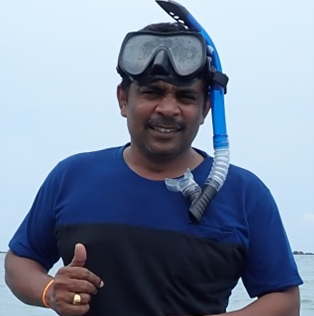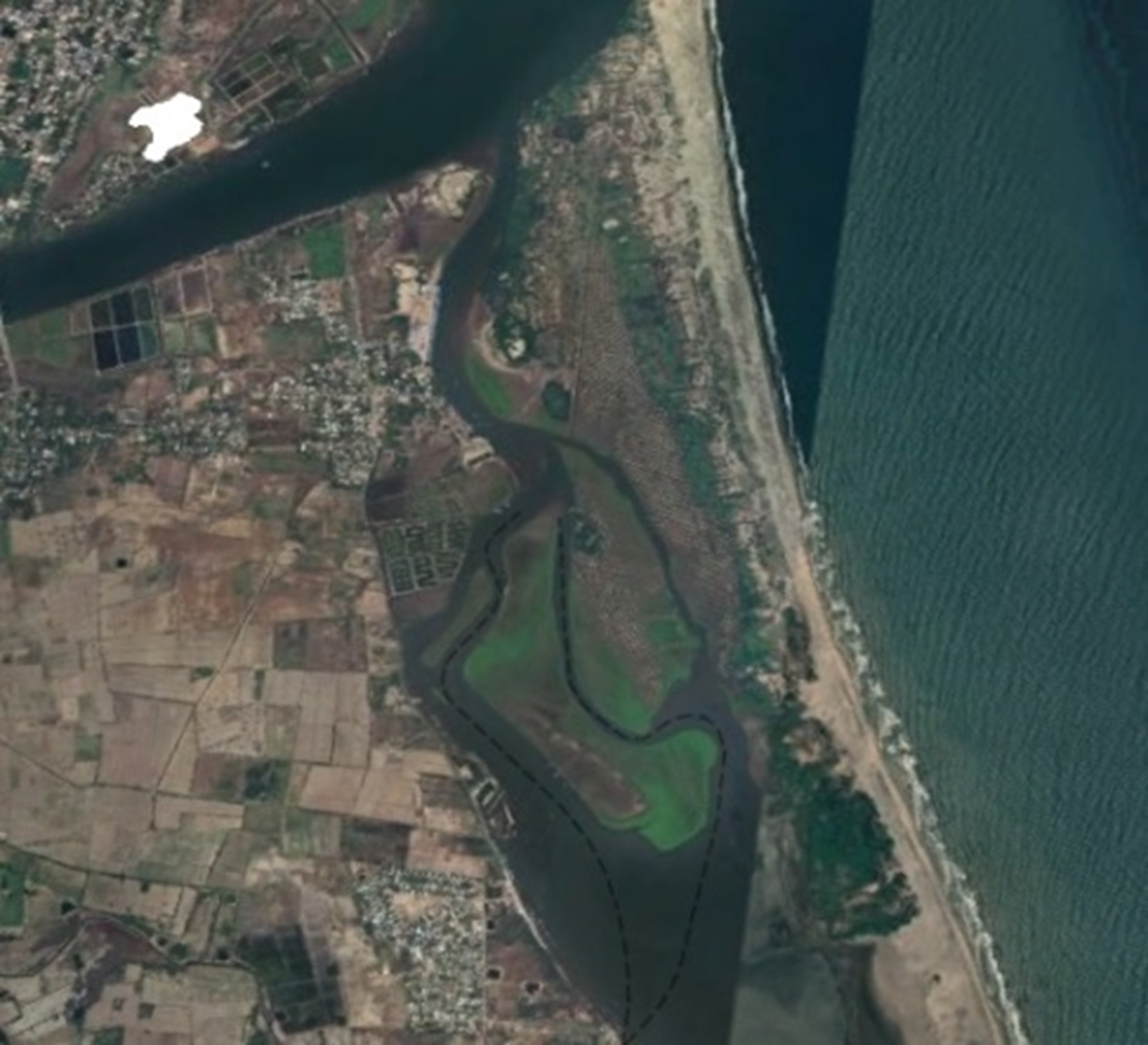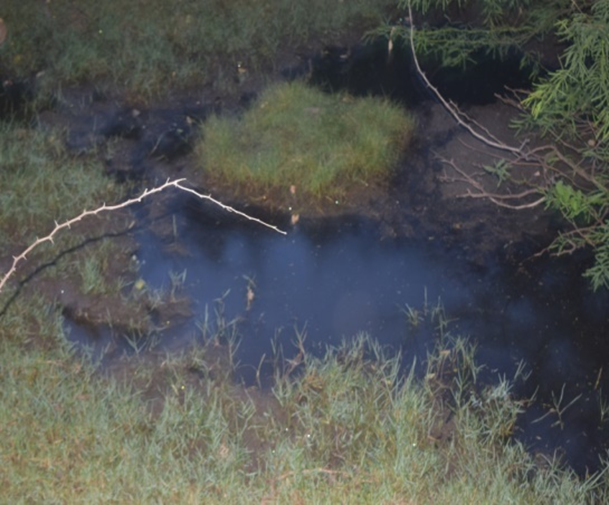IUCN/SSC Otter Specialist Group Bulletin

©IUCN/SCC Otter Specialist Group
Volume 40 Issue 1 (January 2023)
Citation: Utthamapandian, U., Sutaria, D., Francis, P., Arulmohan, R., Alex Kirubakaran,A., Louwin Anand, D. and Saravanakumar, A. (2023). Occurrence of Smooth-Coated Otters (Lutrogale perspicillata) in Mudasal Odai Coastal Backwaters, Tamil Nadu, India. IUCN Otter Spec. Group Bull. 40 (1): 16 - 25
Occurrence of Smooth-Coated Otters (Lutrogale perspicillata) in Mudasal Odai Coastal Backwaters, Tamil Nadu, India
Udhayakumar Utthamapandian1, Dipani Sutaria2,Pichaiyan Francis3, Rathinasami Arulmohan1, Augustinraj Alex Kirubakaran1, Davidkanagaraj Louwin Anand1, and Ayyappan Saravanakumar1*
1Centre of Advanced Study in Marine Biology, Annamalai University, Parangipettai, Cuddalore, Tamil Nadu, India
2Adjunct faculty, College of Science and Engineering, James Cook University, Townsville, Australia
3Wildlife Institute of India, P.O. Box # 18, Chandrabani, Dehradun 248001, Uttarakhand, India
*Corresponding Author Email: asarvaan@gmail.com
Received 7th September 2022, accepted 2nd October 2022
Abstract: The studies on coastal predators are minimal in Tamil Nadu and at large, the whole country. The present study is a recce survey to reveal the presence/absence of otters, population, distribution and human otter interactions in Mudasal Odai backwaters, southern stretch of Vellar estuary, Cuddalore, Tamil Nadu, India. The preliminary survey during the study exposed the presence of two packs of otters, four individuals in one and a standalone animal inhabits the site. The hard structures, features and abundance of prey make the inhabitation easy in the site of interest. The interaction between humans and otters remains to be critical due to the damages caused economically to the local communities by the otters.
Keywords: Smooth-coated otters, Mudasal odai backwaters, Human-otter interaction, Vellar estuary, Cuddalore, Habitat preference
INTRODUCTION
The Indian coastline incorporates myriad biomes and ecosystems which include every tropic level of the local food chain. Among other predators, otters occupy the place of top predators in shallow tributaries of river streams and estuaries. Looking at the three species found in India, Smooth-coated otters (Lutrogale perspicillata) constitute the major part of the population (Johnsingh and Manjrekar, 2013) and can be found in major and minor floodplains, rivers, estuaries and upstreams (Hussain and Choudhury, 1997; Foster-Turley, 1992). Habitat preferences of otters are established by considering the availability of prey such as fishes, shrimps, molluscs, small vertebrates and insects (Hussain and Choudhury, 1998). However, with limited resources, studies on otters are meagre even in terms of population. In accordance with the IUCN Species Red List Index, smooth coated otters are classified as vulnerable and categorized under Schedule II of Indian Wildlife Protection Act, 1972 (De Silva et al., 2015). Otters are considered as biological indicators and are vulnerable to the disruption of habitats by anthropogenic activities (Sutaria, 2013). For these mammals, which rely on land equally, both loss of habitat and poaching are major threats (Raha and Hussain, 2015).
MATERIALS AND METHODOLOGY
Study area
Mudasal Odai (Lat.11°29'N; Long. 79°46' E) backwaters (Fig. 1,2) is a typical nutritious zone which is replenished by the estuarine input of river Vellar from north and the nutrient rich backwaters from Coleroon estuary, which passes through Pichavaram reserve from south. The elevated amount of nutrients is the mainspring for the abundance of prey such as various species of fishes, crabs, shrimps and molluscs. The place also possesses various artificial structures and vegetation which make up the place an suitable habitat for otters.
Methods
The survey was carried out by both walking and using boats. The study area is restricted within the distance of 4km from Mudasal odai fish landing centre intended so that it does not reach the reserved mangrove forest of Pichavaram. Foot surveys were done to assess various habitats including mangroves, mudflats, salt marshes, dense forests of Prosopsis juliflora. The region is engineered well with models including fish bone models for mangrove plantations and mitochondrian models for tidal fish farming.
Data was collected by direct sightings of otters and indirect indications of otter presence such as dens, spraints, pugmarks, tail tracks, groom sites and scratch marks. Interview surveys were done using questionnaires with local fishermen community and traditional fishermen.
RESULTS
Population
The site is highly utilized by local fishermen and Irula tribes due to the large availability of fin fishes and shell fishes. Based on primary evidence, the banks of fish bone models and backwaters are used by, a pack of four otters (Fig. 3.) and a lone individual separately. Both the pack and the lone animal were seen to utilize the same grooming sites (Fig. 4 ) and fishing grounds but separately following different patterns of time and tides.


Habitat Preference
The anthropogenic structures include ponds in the form of ‘fish bone’ pond sets and mitochondrian ponds (Fig. 5), which are difficult to explore by manpower. This makes the habitat suitable as an important site to be inhabited by otters. Along the banks of the backwater, the survey comprised a total of 10 fish bone sets. The dens were seen on the central land patch which facilitates easy ways to escape in all the directions. During the survey, sediment sampling was done by random sampling after identifying the grooming sites. The sloppy banks of fish bone ponds and the silt accumulations are utilized as grooming sites. The sites also possess sandy and clayey texture and not utilized by the animals for digging dens and grooming. On considering the positions of dens, all the three were under the roots of sparse P. juliflora vegetation providing a better substrate for digging (Fig. 6), and provifde cover for hiding.

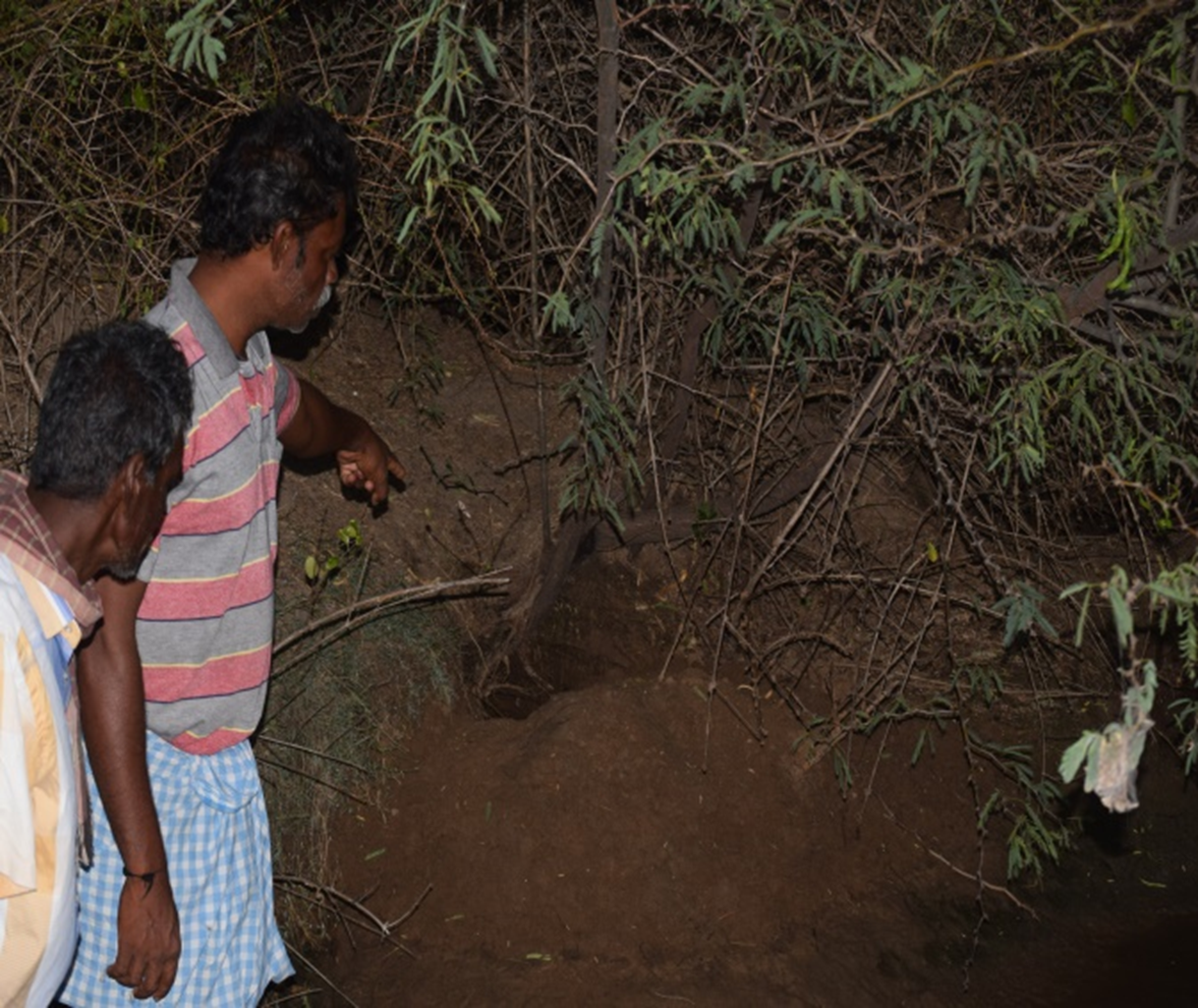
Seasonal Distribution and Drinking Water
The otters were observed in the dense core backwater structures during monsoon and post monsoon seasons, seen near the Irula tribe settlement along the banks, and near to the roads during summer and pre-monsoon seasons. The backwater of Mudasal Odai is influenced by saline water from the estuary of the river Vellar and Pichavaram mangrove reserve. The artificial land patterns on the site tend to retain saline water in confined areas, and this tends to concentrate by evaporation during summer and pre-monsoon seasons. The landmass, and many of the rain-collecting ponds dry out, causing the animals to gather in any remaining rain ponds, seeking fresh water to drink. The otters in the Mudasal Odai backwater have learnt to drink fresh water from the rainwater ponds (Fig. 7) found near the Irula tribal settlements, crossing two busy roads used by local fishermen to get there (Fig. 7). This means that sightings are frequent, during high tide. The marked difference in patterns in seasonal usage of habitats were also confirmed by the interview surveys acquired from the Irula community.
Human Otter Interaction
The banks of Mudalsal Odai backwaters possess mitochondrian type tidal ponds which are frequently hunted in both the group, and lone otters (Fig. 8). Interaction in the process of chasing them out of the ponds is dangerous for the otters (Fig. 8). Foraging behavior also poses a threat to otters because the most used equipment here are gill nets, which the otters raid for fish, damaging the nets which are vital to the livelihood of the fishermen (as is common throughout the area). However, the otters do not appear afraid of either boats or settlements.
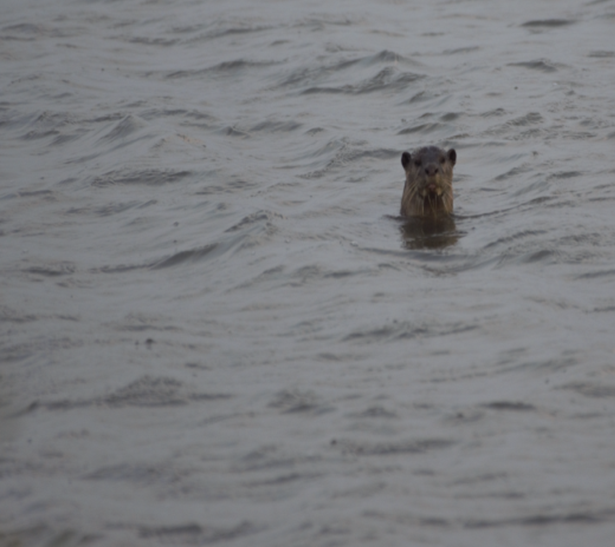
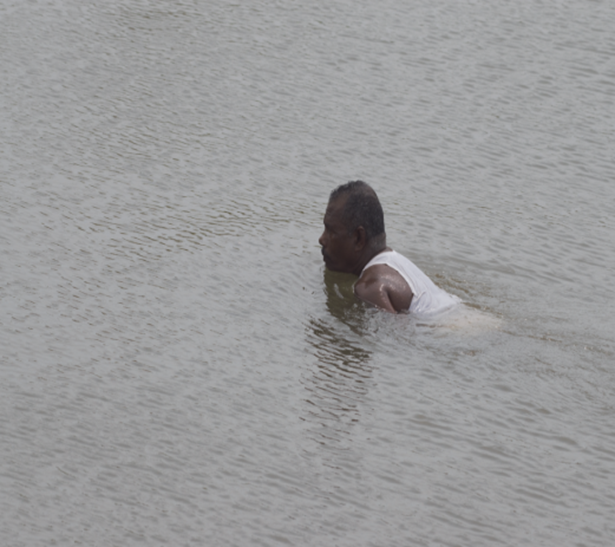
CONCLUSION
The Mudasal Odai backwater is one of the highly exploited areas along the coast of Cuddalore. It constitutes one of the three major fish landing centres of the Vellar estuarine stretch, and local people are highly committed to, and dependent on the fishery business. This study identified five otters in two groups living around the region, exposed to comparatively frequent interaction with the local fishermen. The hard structures and availability of sufficient prey makes the place attractive for otter inhabitation. Even though the behavioural adaptation that the otters exhibit in the site is exceptional, it still leads to negative interaction with local fishermen. The opportunities for road-kill are high whenever the otters cross the roads to drink. In the perception of the local people, in the past, otters were cherished, but in recent times, the foraging of otters in the ponds from which they make their own living is frustrating, but fear of the wildlife protection acts prevents them from terrorizing otters. No mortalities or killings were recorded at the site during the study but without implementing conservation measures and awareness among local community, this will become very likely in the near future.
Acknowledgements: The authors would like to thank Director and Dean, CAS in Marine Biology, Annamalai University. The authors would like to thank Dr. A. Gopalakrishnan, Assistant professor, CAS in Marine Biology, Annamalai University for his help and support. The authors would like to thank Dr. Poornima, Dr. Shanthi, Ms. Priyanka, Mr. Ayyappan, Ms. Dhithya, Mr. Veerappan, Mr. Ramesh and Mrs. Pandimadevi for their help and support..
REFERENCES
de Silva, P., Khan, W.A., Kanchanasaka, B., Reza Lubis, I., Feeroz, M.M., Al-Sheikhly, O.F. (2015). Lutrogale perspicillata. The IUCN Red List of Threatened Species 2015.
No longer available. Superceded by
Khoo, M., Basak, S., Sivasothi, N., de Silva, P.K., and Reza Lubis, I. (2021). Lutrogale perspicillata. The IUCN Red List of Threatened Species 2021: e.T12427A164579961. https://dx.doi.org/10.2305/IUCN.UK.2021-3.RLTS.T12427A164579961.en.
Foster-Turley, P. (1992). Conservation ecology of sympatric Asian otters Aonyx cinerea and Lutra perspicillata. PhD thesis., University of Florida.
Hussain, S.A., Choudhury, B.C. (1998). Feeding ecology of smooth-coated otter Lutraperspicillata in National Chambal Sanctuary. Proceedings of the Symposia of the Zoological Society of London. Behav. Ecol. Riparian Mamm. 71:229-250. https://doi.org/10.1017/CBO9780511721830.015
Hussain, S.A., Choudhury, B.C. (1997). Status and distribution of Smooth-coated Otter Lutra perspicillata in National Chambal Sanctuary. Biological Conservation, 80: 199-206. https://doi.org/10.1016/S0006-3207(96)00033-X
Johnsingh, A.J.T., Manjrekar, N. (2013). Mammals of South Asia, Vol. I. University Press, India.
Raha, A., Hussain, S.A. (2016). Factors affecting habitat selection by three sympatric otter species in the southern Western Ghats, India. Acta Ecologica Sinica, 36: 45-49. https://daneshyari.com/article/preview/4379764.pdf
Sutaria, D., Balaji. V. (2013). A recce survey of Smooth-coated otters (L. p. perspicillata) in the estuaries of Muthupet,Tamil Nadu. OMCAR Foundation. Tamil Nadu, India. https://www.omcar.org/otters
Résumé: Présence de la Loutre à Pelage Lisse (Lutrogale perspicillata) dans les Marigots Côtiers du Mudasal Odai, au Tamil Nadu, en Inde
Les études sur les prédateurs côtiers sont rares au Tamil Nadu et dans l’ensemble du pays. La présente étude est une enquête de reconnaissance visant à révéler la présence/l’absence de loutres, d’une population, sa distribution et les interactions entre l’homme et les loutres dans les marigots de Mudasal Odai, situés au sud de l’estuaire du Vellar, dans le district de Cuddalore, au Tamil Nadu, en Inde. L’enquête préliminaire de l’étude a révélé la présence de deux groupes de loutres : un groupe de quatre individus et un individu solitaire fréquentent le site. La présence de structures durables, les caractéristiques et l’abondance de proies facilitent leur présence dans ce site prioritaire. L’interaction entre l’homme et les loutres reste critique en raison des dommages économiques causés par les loutres aux communautés locales.
Revenez au dessus
Resumen: Ocurrencia de Nutrias Lisas (Lutrogale perspicillata) en los Remansos Costeros de Mudasalodai, Tamil Nadu, India
Los estudios sobre predadores costeros en Tamil Nadu - y en todo el país - son mínimos. Este estudio es un relevamiento de reconocimiento para revelar la presencia/ausencia de nutrias, así como poblaciones, distribución e interacciones humanos-nutrias en los remansos Mudasal Idai, en la franja sur del estuario Vellar, Tamil Nadu, India. El relevamiento preliminar de este estudio expuso la presencia de dos grupos de nutrias, de cuatro individuos en uno y un animal solitario en el otro caso. Las estructuras sólidas, los rasgos del lugar y la abundancia de presas hacen que el sitio de interés sea fácil de habitar. La interacción entre humanos y nutrias resulta ser crítica debido a los daños económicos causados por las nutrias a las comunidades locales.
Vuelva a la tapa
சுருக்கம்:
இந்தியா, தமிழ்நாடு, முடசல் ஓடை கடலோர உப்பங்கழியில் மென்-தோல் நீர்நாய்களின் (லுட்ரோகேல் பெர்ஸ்பிசில்லாட்டா) வாழ்வுமுறை
கடலோர வேட்டை பிராணிகள் பற்றிய ஆய்வுகள் தமிழ்நாடு மற்றும் ஒட்டுமொத்த நாடு முழுவதும் மிகக் குறைவு. தற்போதைய ஆய்வு, இந்தியாவின் தமிழ்நாடு கடலூரில் உள்ள வெள்ளாறு முகத்துவாரத்தின் தென்பகுதியில் உள்ள முடசல் ஓடை உப்பங்கழியில் நீர்நாய்களின் இருப்பு/இல்லாமை, எண்ணிக்கை, வாழ்விட பங்கீடு மற்றும் மனிதன்-நீர்நாய் இடைவினைகள் ஆகியவற்றை வெளிப்படுத்தும் ஒரு ஆய்வாகும். ஆய்வின் போது நடத்தப்பட்ட பூர்வாங்க கணக்கெடுப்பில் இரண்டு நீர்நாய் கூட்டம் இருப்பதும், இவற்றில் ஒன்றில் நான்கு நீர்நாய்களும், ஒரு தனியான விலங்கு அந்த இடத்தில் வசிப்பதும் அம்பலமானது. கடினமான கட்டமைப்புகள், அம்சங்கள் மற்றும் இரையின் மிகுதி ஆகியன இவ்விடத்தை எளிதான வசிப்பிடமாக்குகிறது. நீர்நாய்களால் உள்ளூர் சமூகங்களுக்கு பொருளாதார ரீதியாக ஏற்படும் சேதங்கள் காரணமாக மனிதர்களுக்கும் நீர்நாய்களுக்கும் இடையிலான தொடர்பு முக்கியமானதாக உள்ளது.
ஆரம்பத்திற்குத் திரும்பு
सारांश: मुदसाल ओडीई कोस्टल बैकवाटर्स, तमिल नाडु, भारत में चिकने-लेपित ऊदबिलाव (लूट्रोगेल पर्सपिसिलटा) की उपस्थिति
तमिलनाडु और बड़े पैमाने पर, पूरे देश में तटीय शिकारियों पर अध्ययन न्यूनतम हैं। वर्तमान अध्ययन मुर्दासल ओडाई बैकवाटर्स, वेल्लार मुहाना के दक्षिणी खंड, कुड्डालोर, तमिलनाडु, भारत में ऊदबिलाव, जनसंख्या, वितरण और मानव ऊदबिलाव इंटरैक्शन की उपस्थिति / अनुपस्थिति को प्रकट करने के लिए एक रेकी सर्वेक्षण है। अध्ययन के दौरान प्रारंभिक सर्वेक्षण ने ऊदबिलाव के दो पैक, एक में चार व्यक्तियों और एक अकेला जानवर की उपस्थिति को उजागर किया। शिकार की कठिन संरचनाएं, विशेषताएं और बहुतायत ब्याज की साइट में निवास को आसान बनाती हैं। ऊदबिलाव द्वारा स्थानीय समुदायों को आर्थिक रूप से होने वाले नुकसान के कारण मनुष्यों और ऊदबिलावों के बीच बातचीत नाजुक बनी हुई है।
शुरुआत में वापस जाएं






